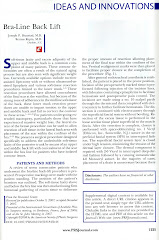Recently I have had a few questions about bulging or fullness following tummy tuck. While there are a handful of reasons for fullness to be noticed some time following the tummy tuck procedure I think the presence of pseudobursa is often under reported or underdiagnosed.
So what is a pseudobursa?
Simply put a pseudobursa is a pocket of extra thick scar tissue. Remember those drains that you had after the tummy tuck? They were necessary to prevent a seroma, or collection of "healing" fluid. Despite the use of drains, however, seroma can still ocurr. It is not hard to imagine that some seroma fluid accumulates after the drains are removed. Of course, the majority of the time the body keeps up with absorption of the seroma fluid and any extra fluid that may be under the abdominal soft-tissue is not noticed. The body naturally wants to isolate any free fluid between the abdominal soft tissue and the abdominal wall. The body knows that it does not belong there so it sends in cells to create scar tissue around the fluid. This scar tissue surrounding a fluid pocket is called a pseudobursa. If the wall of the pseudobursa is thin enough then they usually go undetected. Occasionaly a previously undetectable pseudobursa gets infected. When this ocurrs usually there is some tunneling and drainage at the nearest incision, either the lower incision in the midline or the belly button scar. If the pseudobursa contains a lot of fluid or the scar tissue is very thick it can be noticeable as a bulge or fullness.
The most common areas for pseudobursa formation is just above the waistline incision in the middle. This is the most gravity dependant area so it is naturally the most likely area for pseudobursa formation. Pseudobursa can also be seen just above the belly button. The presence of the belly button stalk and the surrounding tissue can form an area for a seroma to accumulate and for a pseudobursa to form.
How do you treat pseudobursa?
Although the pseudobursa can be injected with medicine to scar the two parts together and reduce the overall size, this is usually not that effective. If the pseudobursa is detected either by the development of infection or because it can be felt or seen as a bulge or fullness then it should be removed. The prior incision scar must be used to access the pseudobursa. The scar tissue is then removed, sutures are placed to obliterate the space where the pseudobursa was located, and drains as well as an abdominal binder are used similar to the original tummy tuck procedure. The recovery process is usually much easier than the original tummy tuck procedure with the exception of the drains and the abdominal binder.
Below is a photo of a pseudobursa excision. Extra skin and soft tissue with the underying pseudobursa was removed. When present on top of the abdominal wall the size of the pseudobursa is actually large and more spread out. Once it is detached from the surrounding tissue it shrinks up. This contractile property is likely related to some of the symptoms patients experience when a pseudobursa is present.
Below is a photo of a pseudobursa excision. Extra skin and soft tissue with the underying pseudobursa was removed. When present on top of the abdominal wall the size of the pseudobursa is actually large and more spread out. Once it is detached from the surrounding tissue it shrinks up. This contractile property is likely related to some of the symptoms patients experience when a pseudobursa is present.
Feel free to ask any questions that I may not have covered. Look for an extended tummy tuck post next.
All the best,
Dr. Remus Repta
Phoenix/Scottsdale, AZ
Phoenix/Scottsdale, AZ








